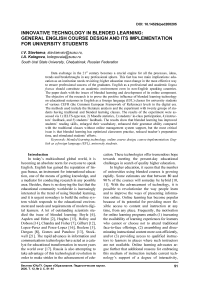Innovative technology in blended learning: general English course design and its implementation for university students
Автор: Stavtseva I.V., Kolegova I.A.
Рубрика: Непрерывное образование в течение жизни. Образование разных уровней
Статья в выпуске: 2 т.12, 2020 года.
Бесплатный доступ
Data exchange in the 21st century becomes a crucial engine for all the processes, ideas, trends and breakthroughs in any professional sphere. This fact has two main implications: education as an institution needs revisiting; higher education must change in the most effective way to ensure professional success of the graduates. English as a professional and academic lingua franca should constitute an academic environment even in non-English speaking countries. The paper deals with the issues of blended learning and development of its online component. The objective of the research is to prove the positive influence of blended learning technology on educational outcomes in English as a foreign language (EFL) classes for university students of various CEFR (the Common European Framework of Reference) levels in the digital era. The methods used include the literature analysis and the experiment with twenty groups of students having traditional and blended learning classes. The results of the experiment were assessed via 1) IELTS-type test, 2) Moodle statistics, 3) students’ in-class participation, 4) instructors’ feedback, and 5) students’ feedback. The results show that blended learning has improved students’ reading skills, enlarged their vocabulary, enhanced their grammar ability compared with the traditional classes without online management system support, but the most critical issue is that blended learning has optimized classroom practice, reduced teacher’s preparation time, and stimulated students’ efforts.
Blended learning technology, online course design, course implementation, english as a foreign language (efl), university students, английский язык как иностранный (efl)
Короткий адрес: https://sciup.org/147233991
IDR: 147233991 | DOI: 10.14529/ped200205
Список литературы Innovative technology in blended learning: general English course design and its implementation for university students
- Allen I.E., Seaman J., Garrett R. Blending in: The Extent and Promise of Blended Education in the United States. Needham, MA, Sloan Center for Online Education Publ., 2007.
- Aspden L., Helm P. Making the Connection in a Blended Learning Environment. Educational Media International, 2004, Release 41 (3). DOI: 10.1080/09523980410001680851
- Ay cock A., Garnham C., Kaleta R. Lessons Learned from the Hybrid Course Project. Teaching with Technology Today, 2002, vol. 8, no. 6.
- Babb S., Stewart C., Johnson R. Constructing Communication in Blended Learning Environments: Students' Perceptions of Good Practice in Hybrid Courses. Journal of Online Learning and Teaching, 2010, vol. 6, no. 4, pp. 735-753.
- Boelens R., Van Laer S., De Wever B., Elen J. Blended Learning in Adult Education: Towards a Definition of Blended Learning. Available at: https://biblio.ugent.be/publication/ 6905076 (accessed 05.02.2020).
- Boyle T., Bradley C., Chalk P., Jones R., Pickard P. Using Blended Learning to Improve Student Success Rates in Learning to Program. Journal of Educational Media, 2003, vol. 28, iss. 2-3, pp. 165-178. DOI: 10.1080/135816503 2000153160
- Chandra V., Fisher D.L. Students' Perceptions of a Blended Webbased Learning Environment. Learning Environments Research, 2009, vol. 12, iss. 1, pp. 31-44. DOI: 10.1007/ s10984-008-9051-6
- Deegan D., Wims P., Pettit T. The Potential of Blended Learning in Agricultural Education of Ireland. International Journal of Agricultural Science, Research and Technology in Extension and Education Systems, 2015, vol. 5, iss. 1, pp. 53-64. DOI: 10.18765/jes.v30i2.5473
- Duhaney D.C. Blended Learning in Education, Training, and Development. Performance Improvement, 2004, vol. 43, iss. 8, pp. 35-38. DOI: 10.1002/pfi.4140430810
- Fink D.L. Creating Significant Learning Experiences: An Integrated Approach to Designing College Courses. Available at: https://www. amazon.com/Creating-Significant-Learning-Experiences-Integrated/dp/1118124251 (accessed 15.02.2020). DOI: 10.21225/d5j303
- Garrison D.R., Kanuka H. Blended learning: Uncovering its Transformative Potential in Higher Education. Internet and Higher Education, 2004, vol. 7, no. 2, pp. 95-105. DOI: 10.1016/j.iheduc.2004.02.001
- Gilbert J., Flores-Zambada R. Development and Implementation of a "Blended" Teaching Course Environment. Journal of Online Learning and Teaching, 2011, vol. 7, no. 2, pp. 244-260.
- Gomes T., Panchoo P. Teaching Climate Change through Blended Learning: A Case Study in a Private Secondary School in Mauritius. IEEE, 2015, pp. 1-5. DOI: 10.1109/cccs.2015.7374179
- Holley D., Dobson C. Encouraging Student Engagement in a Blended Learning Environment: The Use of Contemporary Learning Spaces. Learning, Media and Technology, 2008, vol. 33, iss. 2, pp. 139-150. DOI: 10.1080/ 17439880802097683
- Hughes G. Using Blended Learning to Increase Learner Support and Improve Retention. Teaching in Higher Education, 2007, vol. 12, iss. 3, pp. 349-363. DOI: 10.1080/ 13562510701278690
- Lopez-perez M.V., Perez-Lopez M.C., Rodriguez-Ariza L. Blended Learning in Higher Education: Students' Perceptions and their Relation to Outcomes. Computers & Education, 2011, Release 56 (3), available at: https://www.sdrp. org/(S(czeh2tfqyw2orz553k1w0r45))/reference/ ReferencesPapers.aspx?ReferenceID=1424124 (accessed 20.02.2020). DOI: 10.1016/j.compedu. 2010.10.023
- Nichol J., Watson K. Rhetoric and Reality- the Present and Future of ICT in Education. British Journal of Educational Technology, 2003, vol. 34, iss. 1.
- Nuttall C. Teaching Reading Skills in a Foreign Language. Oxford, Heinemann Publ., 1996.
- Rudestam K.E., Schoenholtz-Read J. The Flourishing of Adult Online Education: An Overview. Los Angeles, CA, Sage Publ., 2010. DOI: 10.1111/j.1467-8535.2010.01060_12.x
- Staker H. The Rise ofK-12 Blended Learning: Profiles of Emerging Models. Available at: http: //www. innosightinstitute. org/blended_ learning_models/ (accessed 20.02.2020).
- Stockwell B.R., Stockwell M.S., Cenna-mo M., Jiang, E. Blended Learning Improves Science Education, 2015, Release 162 (5). Available at: https://www.ncbi.nlm.nih.gov/pubmed/ 26317458 (accessed 25.02.2020). DOI: 10.1016/ j.cell.2015.08.009


